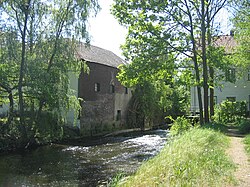Wurm
| Wurm | |
|---|---|
 Zwei Mühlen on the Wurm between Schloss Rimburg (D) and the village of Rimburg (NL) | |
 | |
| Location | |
| State | North Rhine-Westphalia, Germany |
| Reference no. | DE: 2828 |
| Physical characteristics | |
| Source | |
| • location | South of Aachen |
| • coordinates | 50°44′15″N 6°05′16″E / 50.7374694°N 6.0877111°E |
| • elevation | 265 m above sea level (NN) |
| Mouth | |
• location | North of Heinsberg into the Rur |
• coordinates | 51°05′52″N 6°06′23″E / 51.097722°N 6.106250°E |
• elevation | 32 m above sea level (NN) |
| Length | 57.0 km [1] |
| Basin size | 355.518 km² [1] |
| Basin features | |
| Progression | Rur → Meuse → Hollands Diep → North Sea |
| River system | Rhine |
| Landmarks |
|
 Course of the Inde, Wurm and Rur | |
The River Wurm (Template:Lang-nl) is a river in the state of North Rhine-Westphalia in western Germany. It rises in the Eifel mountains and flows for 57 kilometres before discharging into the River Rur.
Geography
The Wurm is a left (western) tributary of the River Rur (Roer River). The Rur becomes a tributary of the Meuse River.
The sources of the Wurm are several brooks in the forests southwest of Aachen, which form the Wurm after the Diepenbenden reservoir. From there the Wurm nowadays flows through canals through the city of Aachen, until it resurfaces at the Europaplatz in the east of Aachen. North of Aachen (between Kerkrade and Herzogenrath) the river forms the border with the Netherlands for approx. 10 km. It flows into the River Rur near Heinsberg.
Other towns on the river Wurm are Würselen, Übach-Palenberg and Geilenkirchen.
The name Wurm is thought to originate from the German word warm (same meaning in English), as the source brooks were fed from the thermal springs in Aachen.
See also
References
- Kalinka, G., Schütten, J., Naturraum Wurmtal, Wurmverlag Herzogenrath 1993
Gallery
-
Meanders of the Wurm near Kohlscheid
-
Wilderness
-
Rimburg Castle near Übach-Palenberg
-
Watermill near Zweibrüggen
-
Castle Trips, Geilenkirchen
-
Wurm valley near Süggerath
-
Wurm at Gut Kalkofen, Aachen







